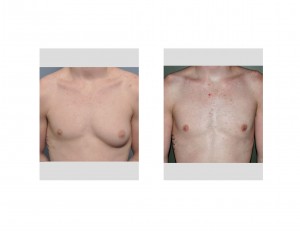
ALTERNATIVES
There are no effective alternatives to surgical gynecomastia reduction. There are no exercises, drugs or weight loss strategies that will work. In very young male teenagers, further physical development may cause some lessening of the size of the breasts in some individuals.
GOALS
The goal of gynecomastia reduction surgery is to decrease the size of the breast tissue to make the chest as flat as possible. This includes the overall shape of the chest as well as the projection of the nipple-areolar complex.
LIMITATIONS
The limits to the amount of gynecomastia reduction is how much chest skin exists and the size of the nipple-areolar complex. The shape of the chest will ultimately be determined by how well the overlying skin shrinks down and adapts to the reduced breast tissue. Excess chest skin, chest skin with stretch marks and a large nipple-areolar complex may fail to produce a completely flat chest based on his elasticity and the amount of skin retraction.
EXPECTED OUTCOME
Expected outcomes include the following: temporary bruising and swelling of the chest, temporary chest skin numbness, temporary vs permanent nipple numbness, permanent scars around the areola and at the side of the chest (if liposuction is used), undercorrection (residual gynecomastia), overcorrection (indentation of the nipple-areolar complex, chest skin irregularities and asymmetry if bilateral gynecomastia reduction is done. Healing of the scars and settling of any chest irregularities is a process that may take months (6 to 12) to see the very final result in many cases.
RISKS
Significant complications from gynecomastia reduction surgery are very rare but could include infection and bleeding. (hematoma) More likely complications could include aesthetic deformities such as asymmetry and irregularities of the chest skin, scar deformities of the areola and chest wall, too little breast tissue removed, too much breast tissue removed and nipple-areolar deformities.Any of these risks may require revisional surgery for improvement.
ADDITIONAL SURGERY
Should additional surgery be required to adjust chest symmetry, remove further breast tissue, correct a nipple-areolar deformity or for scar revision will generate additional costs.


